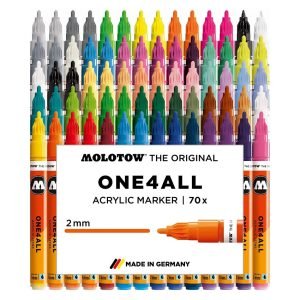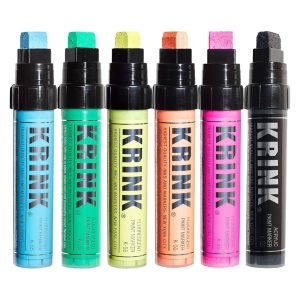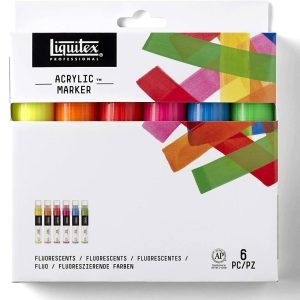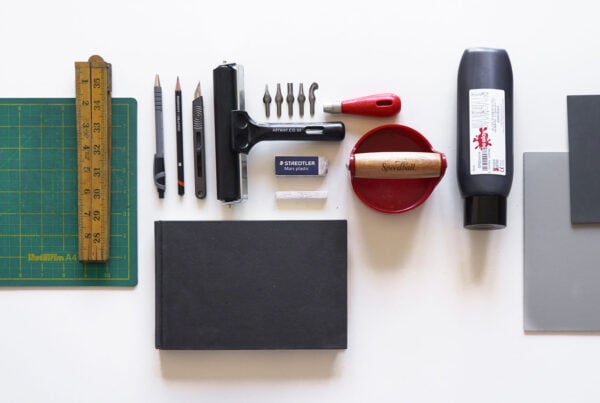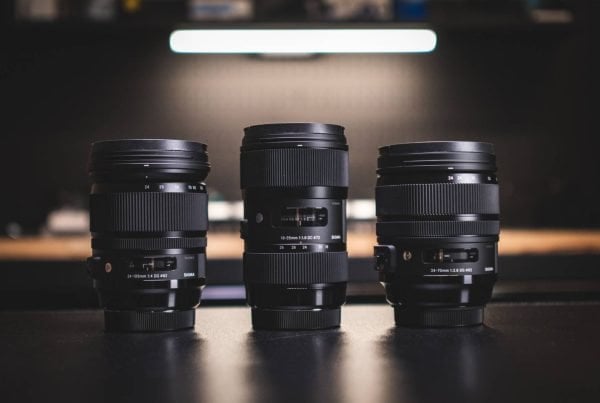Paint markers are a versatile tool in the artist’s toolbox, offering a unique blend of precision, vibrancy, and convenience. Unlike traditional paint and brush, paint markers provide a ready-to-use solution that’s perfect for a wide range of surfaces, from canvas and paper to wood, glass, and even metal. Here’s our guide to the best paint markers available in 2025:
Table of Contents
1. Posca Paint Marker Pens
Used by artists worldwide, including a young Hickman Design, Posca paint markers are an enduring favorite. Manufactured by the Japanese company Uni, Posca paint markers are a favorite among artists for their high-quality pigments and wide range of colours. They offer a selection of tip sizes, from fine points for detailed work to broad tips for filling larger areas. The water-based paint is non-toxic and dries to a matte finish, making these markers a versatile choice for a variety of art projects.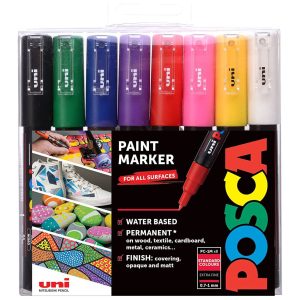
2. Sharpie Oil-Based Paint Markers
Sharpie, a household name in the world of markers, also offers a line of oil-based paint markers. Sharpie paint markers are known for their vibrant colours and excellent coverage. They’re also highly versatile, working well on surfaces such as metal, pottery, wood, rubber, glass, plastic, and stone. The oil-based paint is resistant to water, fading, and abrasion, making these markers a durable choice for outdoor projects.
3. Molotow One4All Acrylic Paint Markers
Molotow’s One4All paint markers use an acrylic-based paint that’s highly pigmented and quick-drying. These markers are refillable, and the tips can be replaced, making them a sustainable and cost-effective choice. The One4All range is also compatible with Molotow’s spray paints, making these markers a great choice for artists who also work in aerosol mediums.
 4. Krink K-55 Acrylic Paint Marker
4. Krink K-55 Acrylic Paint Marker
Krink’s K-55 markers offer a unique fluorescent paint that’s sure to make your artwork pop. The paint is water-based and opaque, offering excellent coverage on both light and dark surfaces. The K-55 also features a unique double-sided tip: a standard chisel tip on one end and a bullet tip on the other, offering artists flexibility in their work.
 5. Liquitex Professional Paint Markers
5. Liquitex Professional Paint Markers
A renowned name in the world of acrylic paints, Liquitex also produces high-quality paint markers. They’re water-based, offering the benefits of easy cleanup and minimal odour. They also come in a wide range of vibrant colours and two tip sizes, providing artists with plenty of choices for their projects.
See Our Paint Pen Marker Kits!
The Science Behind Paint Pen Markers
Paint pen markers, much like their name suggests, are essentially small, handheld paint dispensers. The mechanics of a paint marker are fairly simple but the science that goes into making them work is a bit more complex. Here’s a brief rundown of how paint markers operate:
Structure and Mechanism
A paint marker typically consists of three main parts: the body (or barrel), the valve, and the nib (or tip). The body of the marker acts as a reservoir, holding the paint that will be used. The valve controls the flow of paint from the body to the nib, and the nib is what applies the paint to the surface.
The mechanism of a paint marker is similar to that of a regular marker. When you press down on the nib, it pushes on the valve, opening it and allowing the paint to flow down into the nib. The paint is then absorbed by the material of the nib and is drawn out onto the surface when the nib is dragged across it.
The Paint
The paint inside a paint marker is a combination of color pigments, a binder, and a solvent. The pigments provide the color, the binder holds the pigments together and helps them adhere to the surface, and the solvent keeps the paint in a liquid state inside the marker. When you apply the paint to a surface, the solvent begins to evaporate, leaving behind the pigment and binder which harden to form a durable, colourful mark.
Different types of paint markers use different kinds of binders and solvents, leading to different types of paint. For example, oil-based paint markers use oil as a binder and an organic solvent, while water-based paint markers use water as a solvent and an acrylic polymer as a binder. The type of paint used can greatly affect the properties of the marker, such as how vibrant the colours are, how well the paint adheres to different surfaces, and how resistant the paint is to fading and weather.
What Are Paint Pens Best For?
Paint markers are a highly versatile tool, capable of being used on a wide variety of surfaces, from paper and canvas to wood, glass, and even metal. Because of their convenience and versatility, they’ve become a favorite tool of artists for both fine art and street art. They are also commonly used in industrial applications, for marking parts or writing on surfaces where a regular marker wouldn’t show up or last.
In conclusion, the mechanics and science behind paint pen markers are a fascinating blend of simple design and complex chemistry. The next time you pick up a paint marker, you’ll know there’s more to it than meets the eye!
See Our Paint Pen Marker Kits!
What is the Difference Between Chalk and Paint Pens?
Chalk pens and paint pens, while similar in form, differ significantly in the content they carry and the surfaces they best work on.
Chalk pens, also known as liquid chalk markers, are filled with a water-based pigment ink that’s designed to mimic the look of traditional chalk. They work best on non-porous surfaces like glass, plastic, metal, and specially treated chalkboards. The marks they create can be easily wiped away with a damp cloth, making them an ideal tool for temporary signage or changing displays.
On the other hand, paint pens contain acrylic, oil, or water-based paint. They can be used on a broader range of surfaces, including porous surfaces like paper, wood, fabric, and untreated stone. The marks created by paint pens are more permanent than those from chalk pens, and while they can be removed from some surfaces with the right solvent, they’re generally resistant to smudging and water once dry.
Do Paint Pens Rub Off?
The permanence of paint pens depends on the type of paint used and the surface it’s applied to. Oil and acrylic-based paint pens tend to be quite durable and resistant to rubbing off once they’ve dried, particularly on non-porous surfaces like glass, metal, and plastic. However, on porous surfaces like wood or fabric, the paint can potentially be worn away over time with enough friction.
Water-based paint pens, while still more resistant to rubbing off than regular markers, can be more susceptible to wear and tear, especially when used on surfaces that are frequently handled. Applying a protective sealant over the paint can help improve its durability.
How Long Do You Let a Paint Pen Dry?
The drying time of a paint pen can vary based on the type of paint, the thickness of the application, and the surface it’s applied to. As a general rule, you should allow at least 10-15 minutes for the paint to dry to the touch. However, it can take up to 24 hours for the paint to fully cure and harden. Thicker applications or more porous surfaces may require a longer drying time. Always check the manufacturer’s instructions for the specific drying times of your paint pen.
Do You Store Paint Pens Tip Up or Down?
There are differing opinions on this, and the best method may depend on the specific brand or type of paint pen. Some manufacturers recommend storing paint pens horizontally to keep the paint evenly distributed. Storing them tip down can keep the nib saturated and ready to use, but it may also lead to the pen leaking or the paint drying in the nib if the cap is not properly sealed.
On the other hand, storing them tip up can prevent leaking, but it may cause the paint to settle away from the nib, requiring more vigorous shaking or priming before use.
In general, it’s best to follow the storage instructions provided by the manufacturer of your specific paint pen. If no instructions are given, storing them horizontally is a safe bet.
Paint Pens Final Thoughts
Remember, when choosing a paint marker, consider the type of artwork you’re creating, the surfaces you’ll be working on, and the specific characteristics you need, such as opacity, durability, and tip size. Happy creating!
Note: Please check the safety instructions before using these or any other paint markers, especially if they are to be used by children or in a poorly ventilated area.





